What Percentage Of Deforestation Is Caused By Animal Agriculture
Get the Latest in Your Inbox
Want to stay up to engagement on the state of the earth's forests? Subscribe to our mailing listing.
How much forest has been replaced by specific agricultural commodities?
Of the 7 commodities analyzed,
More
Cattle replaced near twice equally much woods every bit all other commodities combined<fn>Although some commodities take recent data, which makes it possible to estimate deforestation in additional years, all commodities have deforestation data through at least 2015, so total deforestation from 2001 to 2015 is used hither for comparability. See <a href="https://www.wri.org/publication/estimating-role-seven-commodities-agronomics-linked-deforestation">Goldman et al. (2020)</a> for more than data.</fn>
More
All analyzed commodities explain 57 percentage of tree cover loss from agriculture; cattle lone explains 36 pct
More
The hot spots of forest replacement vary by commodity but are by and large concentrated in the tropics
More
Cattle

Oil palm
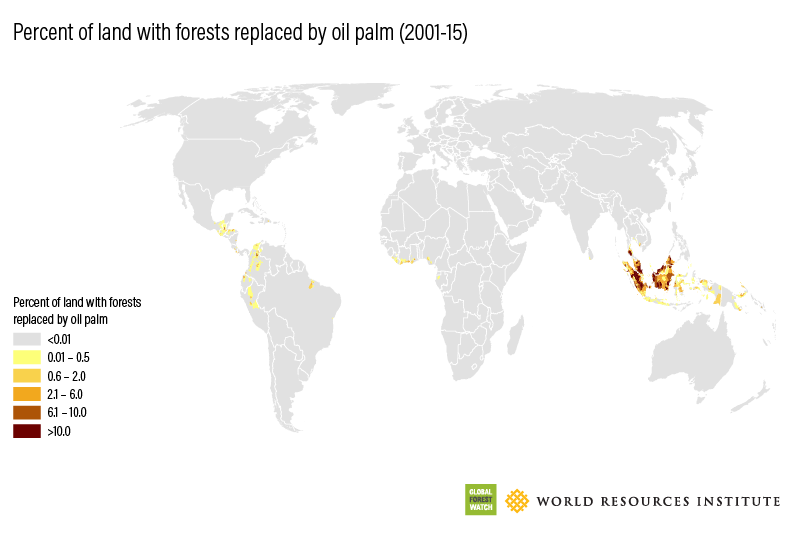
Soy
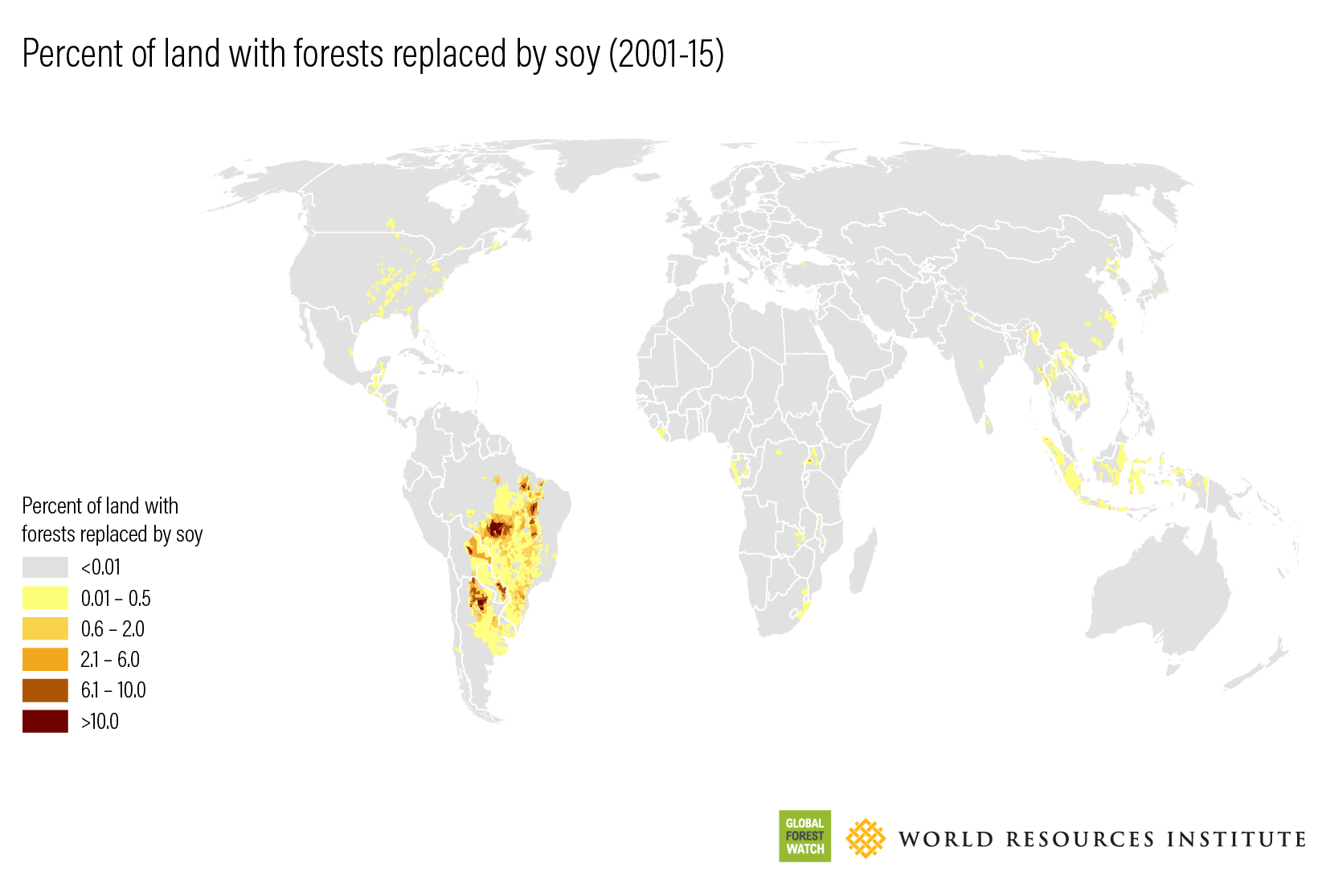
Cocoa

Coffee
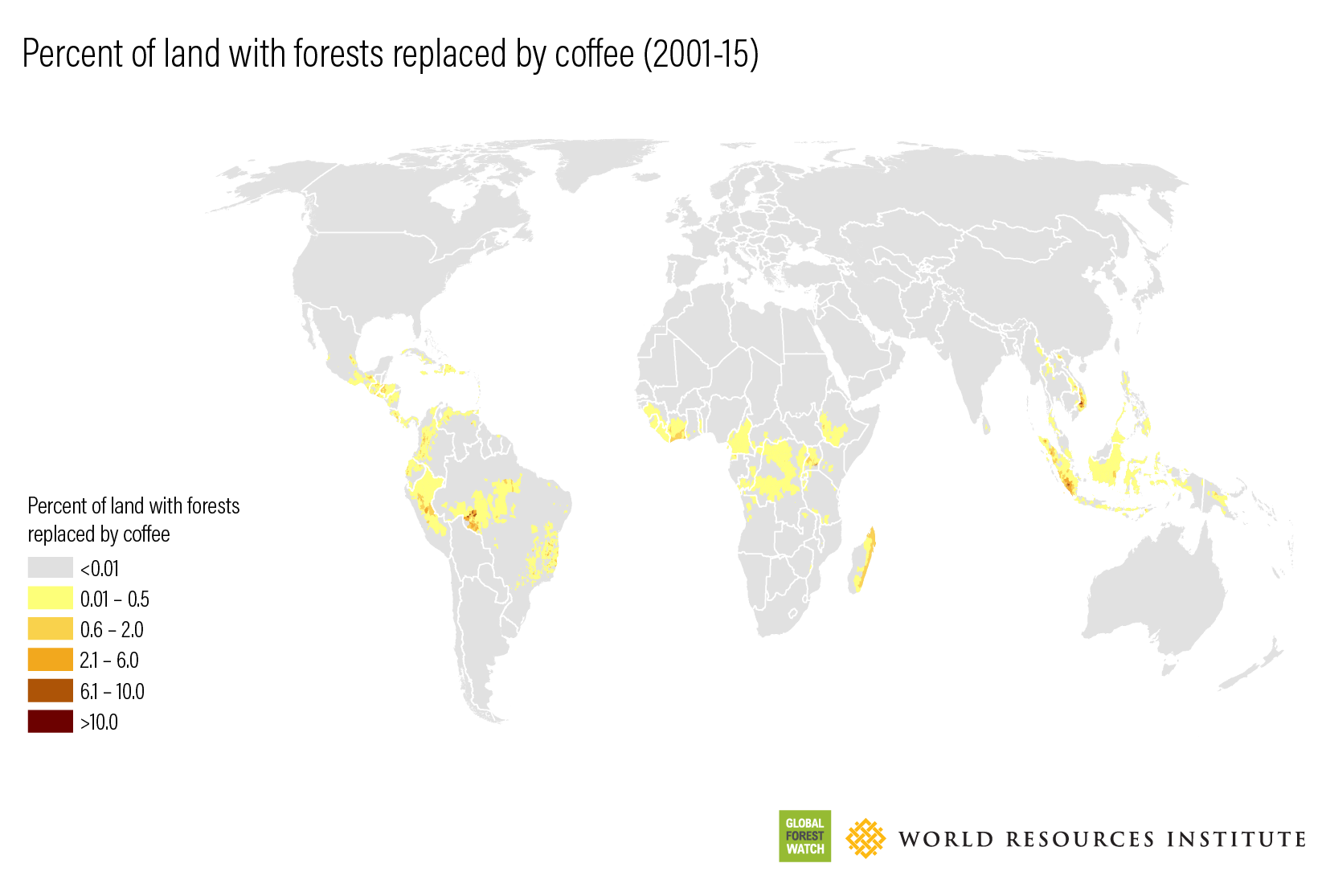
Note: The maps prove the surface area of forest replacement by each ingather as a proportion of each second administrative level's total country area. Maps of forests replaced by wood fiber and rubber plantations are not included hither due to the limited data available.
More
How much woods has been replaced by cattle?
Globally, the conversion of forests to cattle pasture resulted in an estimated 45.i Mha of deforestation betwixt 2001 and 2015, five times more for whatever of the other analyzed bolt.
More
Forest replacement by cattle is most prevalent in Brazil and Paraguay

More than
In Brazil, based on detailed pasture maps bachelor from the Image Processing and Geoprocessing Laboratory (Laboratório de Processamento de Imagens e Geoprocessamento; LAPIG) for the year 2018,
More than
Forest surface area replaced by cattle accounts for 36 percentage of all agronomics-linked tree cover loss worldwide
More than
The Amazon accounted for seventy percent of forest area replaced past cattle in Brazil, with an boosted twenty percent occurring in the Cerrado
More
Motives for converting forests to pasture involve multiple interacting factors. Studies have shown pasture expansion occurring despite very low or negative profit margins for ranching.
In add-on, enquiry has suggested that soy expansion is tightly linked to deforestation for pasture; as soy production expands into former pastures, it pushes pasture farther into forested lands and increases the value of country.
More
How much forest has been replaced past oil palm?
Between 2001 and 2015, oil palm
More
Forest replacement by oil palm is almost prevalent in Southeast Asia
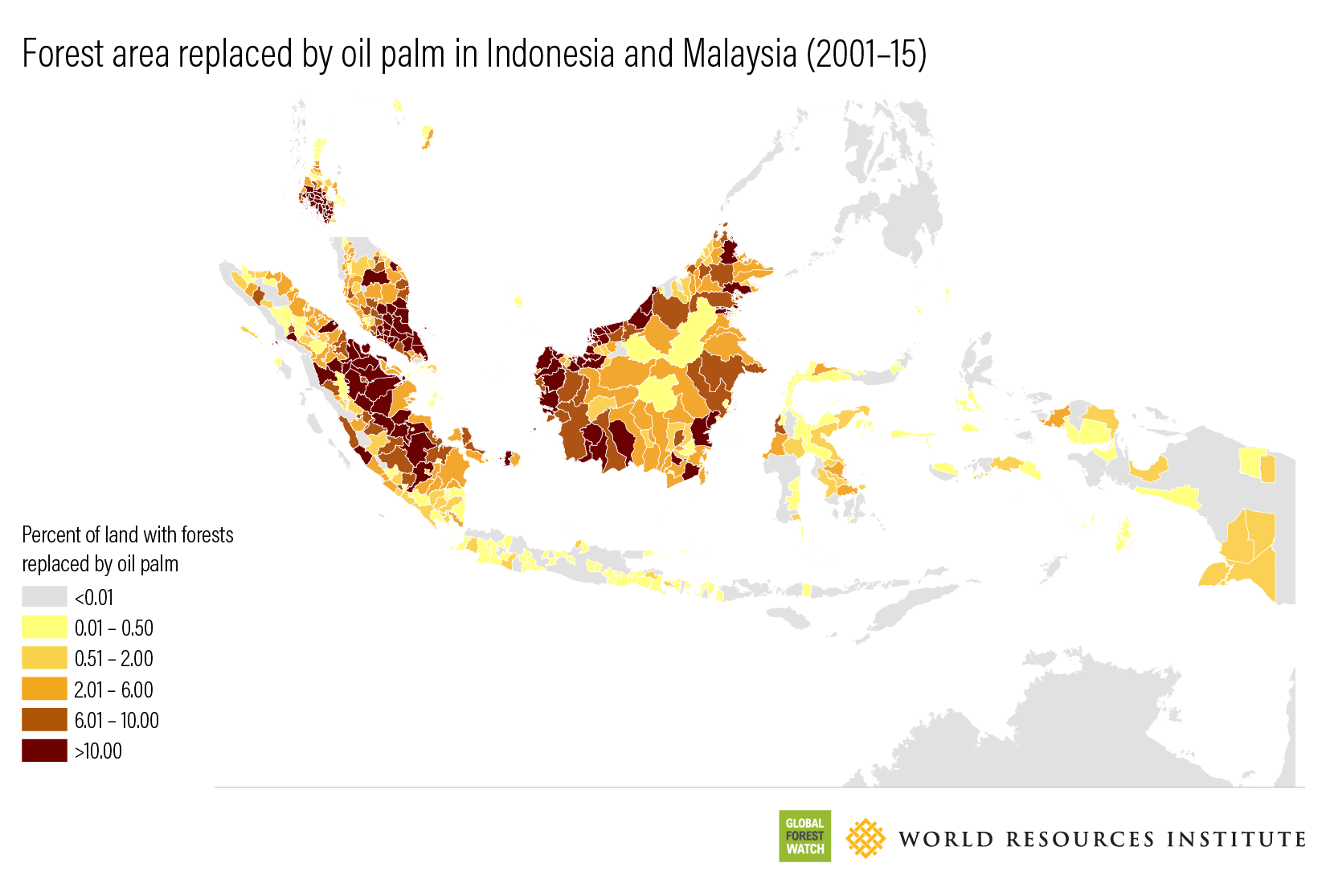
More
The amount of deforestation that occurred previously on country now used for oil palm plantations increased markedly between 2001 and 2012—with peaks in 2009 and 2012–then declined to a tape low in 2015 as office of a more than sixfold pass up in overall deforestation rates in Indonesia and Malaysia. Studies take cited lower prices for crude palm oil (with reductions in deforestation rates mostly lagging toll drops by one year), Republic of indonesia's moratorium on new licenses to convert primary forests and peatlands (implemented in 2011), and corporate cypher-deforestation commitments as possible explanations for the decline.
More
Forest replacement by oil palm spiked in 2009 and 2012
More
Total replaced
Directly replaced
The peaks in the amount of forest area replaced past oil palm correspond to peaks in palm oil prices (offset past a one-year lag)<fn>See World Bank Article Markets, <a href="https://www.worldbank.org/en/enquiry/commodity-markets">https://www.worldbank.org/en/enquiry/commodity-markets</a>.</fn>
More than
Land-apply conversions for oil palm plantations are not e'er straightforward. In Borneo, one study found that at least two-thirds of forest areas converted to industrial plantations (oil palm and wood fiber) were selectively harvested for timber prior to clearance.
More
How much forest has been replaced by soy?
Globally, soy farms occupy 8.2 Mha of land deforested between 2001 and 2015.
More
Forest replacement past soy is most prevalent in a few countries in South America
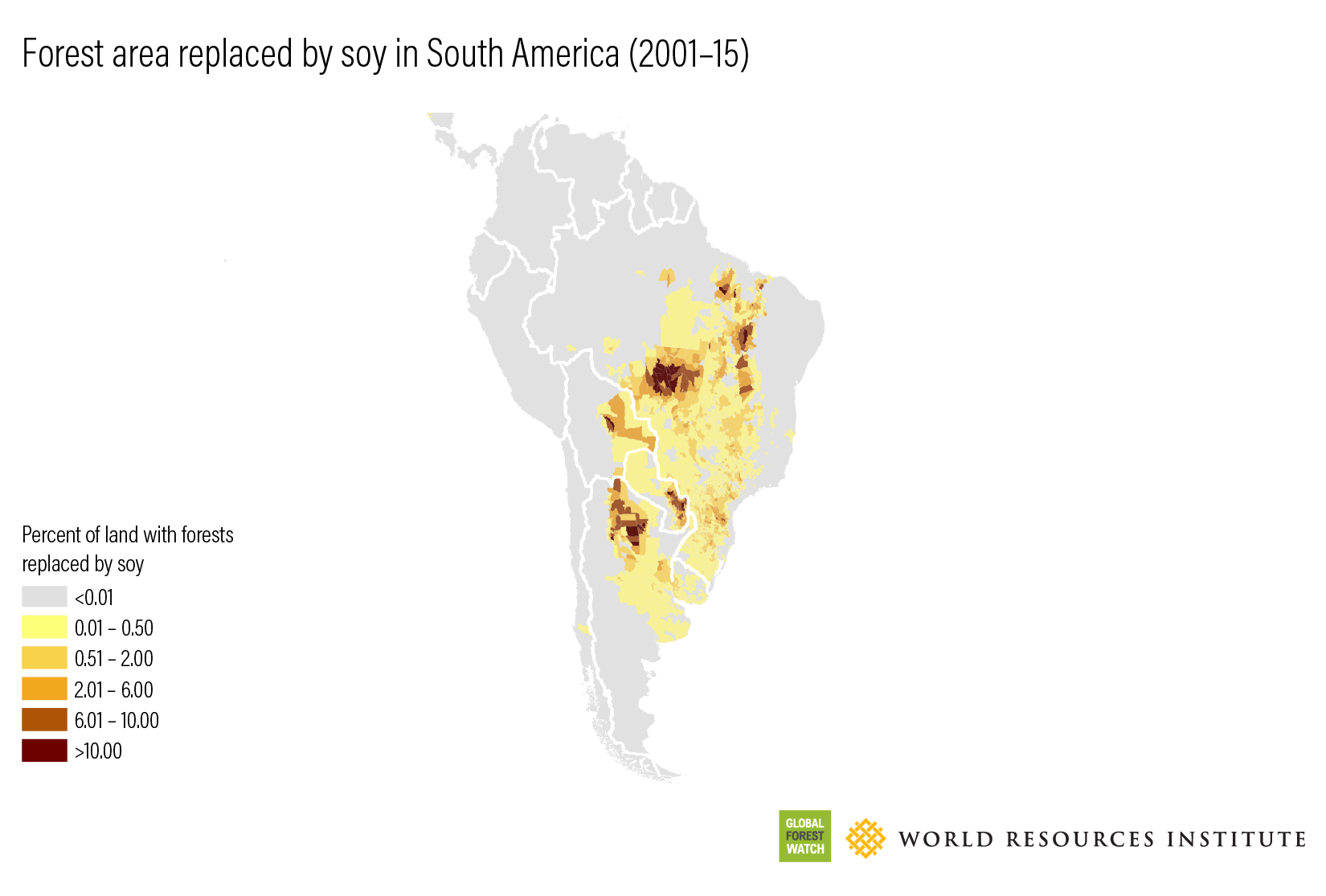
More
In South America, deforestation on state currently used for soy peaked in 2004 and then dropped to around half of that rate thereafter, in line with overall deforestation declines in the Brazilian Amazon, the Brazilian Cerrado, and Paraguay. In that location was besides a second turn down subsequently 2012, most notably in Argentine republic.
More
The area of forest replaced past soy each twelvemonth in South America has markedly decreased since 2004
More
Full replaced
Directly replaced
The drib in forest area replaced past soy during the early 2000s coincides with Brazil's federal programme to reduce deforestation rates in the Amazon (established in 2004), a dip in the profitability of soybeans (2005–7), and the industry-led "soy moratorium" on soy cultivated on recently deforested state in the Brazilian Amazon (implemented in 2006).
A large driblet in the rate at which forests were replaced by soy occurred in the Brazilian Amazon after 2004. The Cerrado also experienced a drop in 2004, though deforestation rates on country later used for soy and then rebounded before some other decline starting in 2013.
The Amazon and Cerrado biomes account for well-nigh of Brazil's forest replacement by soy
Total replaced
Straight replaced
Although the rate at which forests were replaced by soy has declined essentially since the turn of the century, enquiry suggests that soy contributes indirectly to big areas of deforestation in the Amazon.
How much forest has been replaced by cocoa?
Between 2001 and 2015, cocoa farms replaced an estimated 2.3 Mha of forest globally.
More
Woods area replaced by cocoa each year worldwide peaked in 2014
More
Forest replacement by cocoa in W Africa is focused in Côte d'Ivoire, Republic of ghana, and Republic of cameroon

More
How much forest has been replaced by plantation prophylactic?
In the seven countries where safe plantation data are bachelor (Brazil, Cambodia, Cameroon, Democratic Republic of the Congo, India, Indonesia, and Malaysia), rubber plantations replaced 2.1 Mha of wood betwixt 2001 and 2015.
More
Rubber plantations replaced two.ane Mha of forest betwixt 2000 and 2015 <fn>Analyzed countries include Brazil, Cambodia, Cameroon, the Democratic republic of the congo, India, Indonesia, and Malaysia.</fn>
More
How much woods has been replaced by java?
Near 2 Mha of forest were replaced by coffee plantations betwixt 2001 and 2015, of which 1.1 Mha were for robusta coffee and 0.8 Mha were for arabica java.
Deforestation on land after used for robusta coffee increased markedly over the analysis period, but deforestation on state later used for arabica coffee remained steady.
Robusta, more often than not grown in full sun at lower latitudes, is oftentimes used in instant coffee and has seen an increase in demand from consumers in Asia and Brazil.
More
Java replaced 1.ix Mha of forest between 2001 and 2015
More
How much forest has been replaced past plantation wood cobweb?
For the ten tropical countries where wood cobweb plantation data are bachelor (Argentina, Brazil, Cambodia, China, India, Indonesia, Malaysia, Rwanda, South Africa, and Vietnam), wood cobweb plantations replaced an estimated 1.8 Mha of forest between 2000 and 2015.
More
Of countries with available data, wood replacement by wood fiber plantations was near prevalent in Indonesia
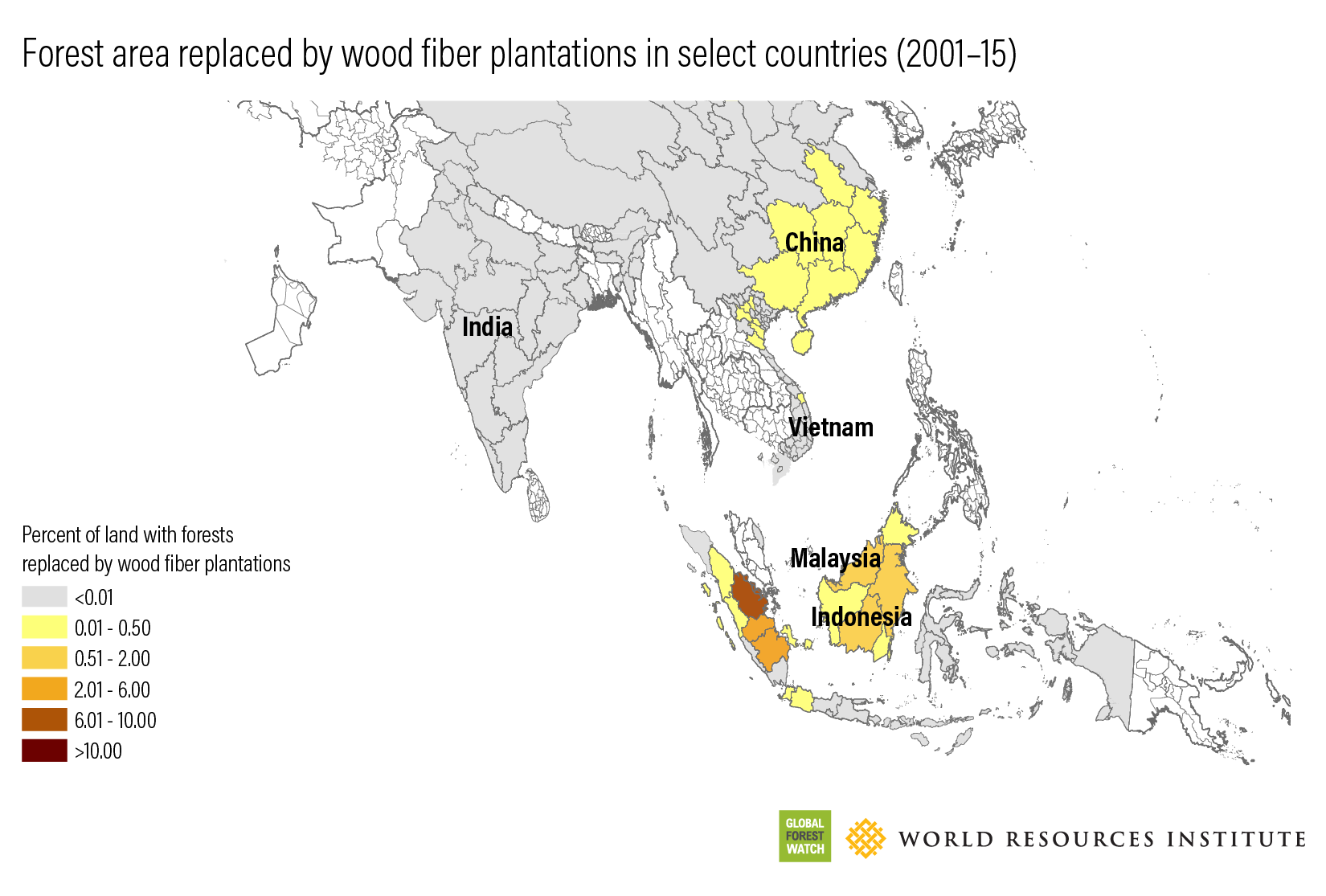
More
The corporeality of wood area replaced by wood fiber plantations each yr increased during the early 2000s and decreased in contempo years <fn>Analyzed for Argentina, Brazil, Cambodia, China, Bharat, Indonesia, Malaysia, Rwanda, S Africa, and Vietnam.</fn>
More
In Indonesia, timber plantation
More
Annual master forest loss in Indonesian timber plantation concessions peaked in 2012, with a substantial reject beginning in 2013
More than
Limitations and Hereafter Prospects
The woods extent analysis is limited past various data and attribution issues and methodological assumptions, including the following:
- Commodity data sets have limited coverage and quality. But oil palm has recent, detailed maps of extent at a global level, and even these maps likely exclude many pocket-size-scale plantations. The analysis too uses detailed data on Southward American soy, Brazilian pasture, and wood fiber and rubber plantations for select countries. Exterior of these regions and commodities, the analysis relies on global ten-kilometer resolution data on crop and pasture extent.
For more information, come across Goldman et al. (2020), https://www.wri.org/publication/estimating-role-seven-bolt-agriculture-linked-deforestation . Due to the coarse resolution of these information, and the assumptions the coarseness necessitates, the results are likely to be less accurate. Furthermore, these data are from 2010 (2000 for pasture), so the corporeality of wood replaced by a specific article is assumed to be proportional to its area during that year and may exist misrepresented if pregnant expansion or wrinkle of that commodity has occurred since then. - The data cannot capture complex land-use change transitions. The analyses presented here do not accept into business relationship other possible state uses between the deforestation event and the establishment of the commodity, except in the cases of oil palm and soy, where we include estimates of direct deforestation. The analysis likewise does not consider any forms of indirect land-use modify (e.chiliad., the target commodity displacing other activities that may, in plough, aggrandize into forested areas). Including indirect land-use modify could change the corporeality of deforestation attributed to each commodity, particularly for oil palm, soy, and cattle.
- The data measure tree embrace loss rather than deforestation directly. All tree cover loss in an area subsequently used for one of the target bolt is causeless to be deforestation considering replacement of a wood with a crop or pasture represents a permanent state-use change. Historical data from Republic of indonesia and Malaysia are used to filter out oil palm plantations established prior to 2000 from the analysis to avert counting the felling of old, unproductive oil palm trees as tree cover loss.
For more than information well-nigh the data sets used in this analysis, see Goldman et al. (2020), https://www.wri.org/publication/estimating-function-seven-commodities-agriculture-linked-deforestation . However, it is possible that some plantation dynamics in oil palm plantations exterior Indonesia and Malaysia, or for other types of plantations, are included in the figures and result in an overestimation of deforestation. - The data may miss some forms of tree cover loss. The tree cover loss data may not notice all changes related to commodity production. Much of the production of cocoa and coffee occurs on very small farms (less than i hectare) that may not be captured past the Hansen et al. (2013)
Hansen et al. 2013, https://doi.org/10.1126/scientific discipline.1244693 . tree cover loss data, resulting in an underestimation of deforestation for these commodities. The analysis may too underestimate the conversion of dry forest and woody savanna areas, which are not well represented in the Hansen et al. (2013) tree encompass loss data. For the detailed soy and pasture analyses, we define tree cover every bit any woody vegetation with a minimum of 10 percent awning comprehend (analyses for other bolt apply xxx percent) to minimize underestimations in Southward American biomes such every bit the Cerrado and the Chaco, where these commodities play a big role.For more than data almost the methodology, see Goldman et al. (2020), https://www.wri.org/publication/estimating-part-seven-commodities-agronomics-linked-deforestation .
Further discussion about the methods, assumptions, and limitations of this analysis is available in Goldman et al. (2020).
More
{"Glossary":{"51":{"proper name":"agricultural tree crops","description":"Trees cultivated for their food, cultural, or economic values. These include oil palm, rubber, cocoa, cashew, mango, oranges (citrus), plantain, banana, and coconut.\r\n"},"101":{"name":"albedo","description":"The ability of surfaces to reflect sunlight.\u0026nbsp;Light-colored surfaces return a large part of the sunrays back to the atmosphere (loftier albedo). Nighttime surfaces blot the rays from the sunday (low albedo).\r\n"},"94":{"proper noun":"biodiversity intactness","clarification":"The proportion and affluence of a location\u0027s original forest community (number of species and individuals) that remain.\u0026nbsp;\r\n"},"95":{"name":"biodiversity significance","description":"The importance of an area for the persistence of forest-dependent species based on range rarity.\r\n"},"98":{"name":"carbon dioxide equivalent (CO2e)","description":"Carbon dioxide equivalent (CO2e) is a measure used to aggregate emissions from various greenhouse gases (GHGs) on the ground of their 100-year global warming potentials by equating non-CO2 GHGs to the equivalent amount of CO2.\r\north"},"99":{"name":"CO2e","description":"Carbon dioxide equivalent (CO2e) is a measure used to aggregate emissions from various greenhouse gases (GHGs) on the footing of their 100-year global warming potentials by equating non-CO2 GHGs to the equivalent corporeality of CO2.\r\n"},"i":{"proper noun":"deforestation","description":"The change from forest to another state cover or land employ, such equally forest to plantation or woods to urban area.\r\north"},"77":{"name":"deforested","description":"The change from forest to another land cover or land employ, such as woods to plantation or forest to urban expanse.\r\due north"},"76":{"name":"deposition","description":"The reduction in a forest\u2019s ability to perform ecosystem services, such as carbon storage and water regulation, due to natural and anthropogenic changes.\r\due north"},"75":{"proper noun":"degraded","description":"The reduction in a woods\u2019s ability to perform ecosystem services, such as carbon storage and water regulation, due to natural and anthropogenic changes.\r\n"},"79":{"proper noun":"disturbances","clarification":"A discrete event that changes the structure of a forest ecosystem.\r\n"},"68":{"name":"disturbed","clarification":"A discrete event that changes the structure of a wood ecosystem.\r\n"},"65":{"name":"commuter of tree cover loss","description":"The straight cause of forest disturbance.\r\northward"},"70":{"proper name":"drivers of loss","clarification":"The straight cause of forest disturbance.\r\due north"},"81":{"proper noun":"drivers of tree cover loss","description":"The direct cause of forest disturbance.\r\n"},"102":{"name":"evapotranspiration","description":"When solar energy hitting a forest converts liquid h2o into water vapor (carrying free energy equally latent oestrus) through evaporation and transpiration.\r\n"},"2":{"name":"woods","clarification":"Forests include tree cover greater than xxx percent tree canopy density and greater than five meters in height as mapped at a 30-meter Landsat pixel scale.\r\n"},"3":{"proper noun":"woods concession","description":"A legal understanding assuasive an entity the right to manage a public forest for production purposes.\r\due north"},"90":{"name":"wood concessions","description":"A legal agreement allowing an entity the right to manage a public wood for production purposes.\r\n"},"53":{"proper name":"forest degradation","clarification":"The reduction in a wood\u2019s ability to perform ecosystem services, such as carbon storage and h2o regulation, due to natural and anthropogenic changes.\r\n"},"54":{"proper noun":"forest disturbance","description":"A discrete event that changes the construction of a forest ecosystem.\r\n"},"100":{"name":"woods disturbances","description":"A discrete outcome that changes the structure of a forest ecosystem.\r\due north"},"5":{"proper name":"forest fragmentation","description":"The breaking of large, contiguous forests into smaller pieces, with other land comprehend types interspersed.\r\n"},"6":{"name":"wood management plan","description":"A plan that documents the stewardship and use of forests and other wooded land to meet environmental, economic, social, and cultural objectives. Such plans are typically implemented past companies in woods concessions.\r\n"},"62":{"proper name":"forests","description":"Forests include tree embrace greater than 30 percent tree awning density and greater than 5 meters in height equally mapped at a 30-meter Landsat pixel scale.\r\n"},"69":{"proper name":"fragmentation","description":"The breaking of large, face-to-face forests into smaller pieces, with other state cover types interspersed.\r\n"},"lxxx":{"proper noun":"fragmented","description":"The breaking of large, face-to-face forests into smaller pieces, with other state comprehend types interspersed.\r\n"},"74":{"name":"gain","description":"The establishment of tree awning in an area that previously had no tree cover. Tree cover gain may indicate a number of potential activities, including natural forest growth or the crop rotation cycle of tree plantations.\r\northward"},"7":{"name":"hectare","description":"One hectare equals 100 foursquare meters, 2.47 acres, or 0.01 square kilometers and is about the size of a rugby field. A football pitch is slightly smaller than a hectare (pitches are between 0.62 and 0.82 hectares).\r\n"},"66":{"proper noun":"hectares","clarification":"One hectare equals 100 square meters, 2.47 acres, or 0.01 square kilometers and is about the size of a rugby field. A football pitch is slightly smaller than a hectare (pitches are between 0.62 and 0.82 hectares).\r\n"},"67":{"name":"intact","description":"A forest that contains no signs of human activity or habitat fragmentation as determined by remote sensing images and is large enough to maintain all native biological biodiversity.\r\n"},"78":{"proper noun":"intact forest","description":"A forest that contains no signs of human activity or habitat fragmentation every bit determined by remote sensing images and is large enough to maintain all native biological biodiversity.\r\northward"},"8":{"name":"intact forests","description":"A forest that contains no signs of human activity or habitat fragmentation as determined by remote sensing images and is large plenty to maintain all native biological biodiversity.\r\n"},"55":{"proper name":"country and environmental defenders","description":"People who peacefully promote and protect rights related to land and\/or the environment.\r\n"},"9":{"name":"loss driver","description":"The direct cause of forest disturbance.\r\n"},"10":{"name":"depression tree canopy density","description":"Less than 30 percent tree canopy density.\r\n"},"84":{"proper name":"managed forest concession","description":"Areas where governments have given rights to individual companies to harvest timber and other wood products from natural forests on public lands.\r\n"},"83":{"name":"managed forest concession maps for nine countries","description":"Cameroon, Canada, Central African Commonwealth, Democratic Republic of the Congo, Republic of equatorial guinea, Gabon, Indonesia, Liberia, and the Republic of the Congo\r\due north"},"91":{"name":"megacities","description":"A city with more than 10 one thousand thousand people.\r\northward"},"57":{"name":"megacity","description":"A city with more than 10 1000000 people."},"56":{"name":"mosaic restoration","description":"Restoration that integrates trees into mixed-utilise landscapes, such equally agronomical lands and settlements, where copse can back up people through improved water quality, increased soil fertility, and other ecosystem services. This type of restoration is more likely in deforested or degraded forest landscapes with moderate population density (10\u2013100 people per foursquare kilometer). "},"86":{"proper name":"natural","description":"A wood that is grown without man intervention.\r\n"},"12":{"name":"natural forest","clarification":"A wood that is grown without human being intervention.\r\due north"},"63":{"name":"natural forests","clarification":"A wood that is grown without human intervention.\r\n"},"82":{"proper noun":"persistent gain","clarification":"Forests that have experienced one gain consequence from 2001 to 2016.\r\north"},"thirteen":{"name":"persistent loss and gain","description":"Forests that have experienced one loss or one gain event from 2001 to 2016."},"97":{"name":"plantation","clarification":"An expanse in which trees have been planted, generally for commercial purposes.\u0026nbsp;\r\north"},"93":{"proper name":"plantations","description":"An surface area in which trees accept been planted, generally for commercial purposes.\u0026nbsp;\r\north"},"88":{"proper noun":"planted","description":"A forest equanimous of trees that have been deliberately planted and\/or seeded by humans.\r\n"},"14":{"proper noun":"planted forest","description":"A woods composed of trees that have been deliberately planted and\/or seeded past humans.\r\n"},"73":{"name":"planted forests","description":"A forest composed of copse that accept been deliberately planted and\/or seeded by humans.\r\n"},"15":{"name":"principal forest","description":"Former-growth forests that are typically high in carbon stock and rich in biodiversity. The GFR uses a boiling tropical primary rainforest data set, representing forests in the boiling tropics that accept non been cleared in recent years.\r\n"},"64":{"name":"primary forests","clarification":"Old-growth forests that are typically high in carbon stock and rich in biodiversity. The GFR uses a humid tropical chief rainforest data set, representing forests in the humid tropics that take not been cleared in recent years.\r\n"},"58":{"proper noun":"production woods","description":"A forest where the chief management objective is to produce timber, pulp, fuelwood, and\/or nonwood forest products."},"89":{"name":"product forests","description":"A woods where the main management objective is to produce timber, pulp, fuelwood, and\/or nonwood forest products.\r\n"},"87":{"proper noun":"seminatural","description":"A managed forest modified by humans, which can have a different species limerick from surrounding natural forests.\r\northward"},"59":{"proper noun":"seminatural forests","description":"A managed wood modified by humans, which can accept a unlike species composition from surrounding natural forests. "},"96":{"proper noun":"shifting agronomics","clarification":"Temporary loss or permanent deforestation due to small- and medium-scale agriculture.\r\n"},"103":{"proper noun":"surface roughness","description":"Surface roughness of forests creates\u0026nbsp;turbulence that slows near-surface winds and cools the land as it lifts heat from depression-albedo leaves and moisture from evapotranspiration loftier into the atmosphere and slows otherwise-drying winds. \r\due north"},"17":{"name":"tree encompass","clarification":"All vegetation greater than five meters in tiptop and may take the form of natural forests or plantations across a range of canopy densities. Unless otherwise specified, the GFR uses greater than thirty pct tree awning density for calculations.\r\northward"},"71":{"proper noun":"tree cover canopy density is low","description":"Less than 30 per centum tree canopy density.\r\n"},"60":{"name":"tree embrace gain","clarification":"The establishment of tree canopy in an area that previously had no tree cover. Tree comprehend gain may indicate a number of potential activities, including natural forest growth or the ingather rotation bicycle of tree plantations."},"18":{"proper noun":"tree embrace loss","description":"The removal or mortality of tree cover, which tin be due to a variety of factors, including mechanical harvesting, fire, disease, or storm impairment. Every bit such, loss does not equate to deforestation. "},"19":{"name":"tree plantation","clarification":"An agronomical plantation of fast-growing tree species on brusk rotations for the product of timber, pulp, or fruit.\r\north"},"72":{"name":"tree plantations","description":"An agricultural plantation of fast-growing tree species on short rotations for the production of timber, pulp, or fruit.\r\due north"},"85":{"proper name":"trees exterior forests","description":"Trees establish in urban areas, aslope roads, or within agricultural land\u0026nbsp;are often referred to equally Trees Exterior Forests (TOF).\u202f\r\n"}}}
Source: https://research.wri.org/gfr/forest-extent-indicators/deforestation-agriculture
Posted by: heidrickwred1975.blogspot.com

0 Response to "What Percentage Of Deforestation Is Caused By Animal Agriculture"
Post a Comment